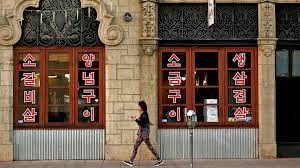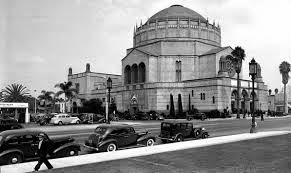http://www.latimes.com/entertainment/arts/la-et-cm-immigration-architecture-20141130s-story.html#pages=1
 |
I. Magnin Building storefront
Myron Hunt, 1941
Los Angeles, California
latimes.com |
Hello Everyone:
This week we are taking a look at how immigrants shaped the city Los Angeles. Christopher Hawthorne is our guide for this three-part look at how Korean, Chinese, and Latino immigrants altered the face of urbanism in the "City of Angels." Today we look at Koreatown, with the help of Mr. Hawthorne's fascinating article "Koreatown's Cool Old Buildings Point To L.A.'s Future." What makes this story so fascinating is how older buildings have been repurposed for use by the Korean community instead of being demolished.
 |
Koreatown map
en.wikipedia.org |
Koreatown, K-town to the locals is bustling neighborhood that encompasses a descent sized section of mid-city Los Angeles. Yours truly has encountered K-town in the early hours of the morning, during a daily run. In the early hours, K-town is just waking up. In the stillness of the early morning, the random school child and worker is making his or her way to their prescribed destination, stopping at local fast food outlet or market for a quick bite. Buses roar down the street and sidewalk slowly comes to life. By day, shoppers, workers, and school children crowd the streets on their way to work, school or bargain hunt. At night, the bars and clubs are crowded with young Korean men and women munching on snacks, drinking beer, and dancing to the latest K-Pop sensation.
One such club is the S-Bar, located in architect Myron Hunt's I. Magnin building on Wilshire Boulevard. S-Bar and the businesses located in the Wilshire Galleria cater mainly to a Korean and Korean American clientele not only keeps the building economically viable but also has saved the Art Deco landmark from a date with the wrecking ball. Mr. Hawthorne writes, "The relationship between the nightclub and the building suggests the peculiar respect-jostling, energetic and impious-Koreatown shows the architecture of its how city." He observes, "If K-town increasingly resembles empire on the march, gobbling up new territory by the week, it is not an empire made of bricks and mortar. It is a net draped over the existing cityscape, a net of signage and light, easily stretched and infinitely expandable. It fills, cloaks or remakes spaces in the city others had abandoned or forgotten about."
 |
Koreatown
en.wikipedia.org
|
Los Angeles has the unfortunate reputation of often demolishing its best-known and much loved landmarks in order to clear a path for the future. K-town is an island set among a primarily Latino neighborhood, served by mass transit lines. K-town is a booming lively commercial for a more intensely urban city. Yet, it is also a mirror of a city whose immigrants have become more engrained, gaining enough clout to have a say in public and private architecture. Southern California is region of immigrant: "36% of the Los Angeles County population was born outside the U.S., a figure three times the national average." However, immigration to Los Angeles County in 1990. Foreign-born immigrants are older, more connected, socially and financially more stable. Citing a recent study, "...just 5% of children here are immigrants but that a remarkable 60% have at least one immigrant parent."
 |
K-town shopping center
city-data.com |
As Washington continues to dither on legal and illegal immigration, the rest of the United States turns to Los Angeles to see the cultural future, in essence, "to see how a metropolitan region, over many decades, has dealt with profound demographic change. When Los Angeles wants to gaze into the urban crystal ball to see its future, the image reflected back is K-town.
The first Koreans came to Los Angeles in the nineteen century, in small group that included Presbyterian evangelists. They first settled on Bunker Hill and later near my alma mater USC. In the sixties, thanks to relaxed federal immigration laws, Koreans began arriving in larger numbers. Many found housing and/or opened businesses in the one-time glamourous mid-Wilshire area. Rents were very low and there were an available number of buildings, including those in the Art Deco mode and post-World War II glass and steel towers. "The buildings were not in great shape," declared Katherine Yungmee Kim, author of a recent book on Koreatown. She adds, "And dome them are still not in great shape. But they're intensely beautiful." Yes, they are.
 |
Friendship Motor Inn, near Koreatown
friendshipmotorinn.net |
Hi Duk Lee arrived in Los Angeles from South Korea in 1968 and became K-town's postwar growth biggest champion. His grand plans, which included a huge hotel built in the manner of traditional Korean style, were never implemented. However, he opened the popular VIP Palace restaurant on Olympic Boulevard and helped convince the late Mayor Tom Bradley in 1980 to officially name the neighborhood "Koreatown."
The stability of the neighborhood was destroyed during the 1992 riots which exposed a deep schism between the Korean and African America communities, whom the merchants saw as intruders or worse. Hundreds of business were burned during the week-long violence. Although the destruction convinced many Korean Americans to sell their businesses or head for the suburbs, including developer and entrepreneur Kee-Whan Ha. Mr. Ha owned a small chain of Hannam supermarkets at the time of the riots and would later buy the Wilshire Galleria. As the rampage intensified, he took to Radio Korea to exhort the merchants to stay and defend their businesses, by force if necessary. "Don't go home," he begged. "Protect your business. Your business is your life." Following his own plea, Mr. Ha drove to his store on Olympic Boulevard, stood on the roof with friends and family, gun in hand ready to defend his store. Mr. Ha's plaint, "Don't go home," suggested a truism then and now, many Koreans who own businesses live elsewhere. Currently, the residential population of the community is 52 percent Latino, 21 percent Korean, 7 percent Caucasian, and 5 percent African American.
 |
Wilshire Galleria
southlandarchitecture.com |
Koreatown's expansion appears relentless. It is about two miles wide Crenshaw Boulevard to Virgil Avenue and approximately the same deep: Beverly Boulevard south to Olympic. There is some new construction taking place, such as a new glass and steel- condominium tower named the Vermont and the Wilshire Grand Center, a few miles east of downtown, is a 73-story tower built by the Hanjin Group. However, K-town's most stunning landmarks are existing places lightly clad in a way that suggests friendly, yet reversible take over. Among the landmarks is the Chapman Park Market on Sixth Street by Stiles O. Clement (1928).
 |
Chapman Market
Stiles O.Clements, 1928
commons.wikimedia.org |
The Chapman Market underwent a careful restoration by architect Brenda Levin and developer Wayne Ratkovich in 1990. The courtyard shopping center is the first drive-in market in America. The market's Spanish Revival decoration was repaired and a large "Chapman" sign was attached to the red-tiled roof paralleling 6th Street. After the riots, business halted and Mr. Ratkovich was forced to sell. At this point, the market got a second albeit less reverential makeover. Christmas tree-type lighting are carefully draped on every inch of exposed roofline and the Chapman sign. The restaurants and coffee bars, now housed within, are packed every weekend with Koreans and Korean Americans.
 |
The Line Hotel
flickr.com |
The epicenter of nightlife in Koreatown is the Line Hotel on Wilshire, occupying a 12-story concrete block built in 1964 intended as a Hyatt Hotel. It was remade by Roy Choi, he of Kogi taco truck fame, and designer Sean Knibb. Mr. Knibbs said, "In Koreatown...so many powerful old buildings had lost their way. The city was really focused on Hollywood and the beach. Everything in between was sort of left to rot." It is usually the in between that is the more interesting part and Koreatown is no exception. There has been other, more expensive, preservation work recently completed in K-town. One example is the $150-million restoration of the Wilshire Boulevard Temple (1929 A.M. Edelman). Another, kitschier, example is the Prince Restaurant and Bar on the ground floor of a 1927 apartment building on 7th Street. Unfortunately, not every landmark in Koreatown is primed for restoration and reuse.
 |
Artist's sketch of the Ambassador Hotel
Myron Hunt, 1921
paulrwilliamsproject.org |
The Ambassador Hotel, the site of six early Oscar ceremonies and the assassination of Robert F. Kennedy in 1968, was razed in 2005 despite vehement objections by preservationists. The Los Angeles Unified School District replaced with a complex of public school. Christopher Hawthorne speculates, "The school district might face a tougher demolition fight today, thanks to the impressive string of restoration projects nearby. Koreatown, like downtown, has helped make old buildings cool again in Los Angeles." Yeah.
Another thing that has become apparent, as a result of these lovely restorations, is a denser Los Angeles, alarming for some; appealing for others. Architect and developer Christopher Pak, responsible for the 22-story Solair apartment tower above the Wilshire and Western Avenue subway station, said "the neighborhood was drawing new residents, many of the them college students or recent graduates from Seoul, who want urban amenities even if that means living in small spaces. Mr. Pak continues, "For them...quality of life is not a big house and a backyard...It's time. If they can walk downstairs and get breakfast or go to the market, instead of spending 20 minutes each way driving, that's a big advantage." Blogger concurs with this idea of quality of life.
 |
Wilshire Boulevard Temple c.1939
kcet.org |
Another lingering Los Angeles stereotype is that it relies on an architecture of detachment. The Music Center started out detached from its surroundings and now seems out of context with the emerging vibrant community around it. Other famous landmarks: the Griffith Observatory, Dodger Stadium, Pierre Koenig's Case Study House No. 22 all stand apart from the city, set atop hillside lots or adrift in a sea of parking spaces. Thus, it is easy to understand immigrant neighbors-Thai Town, Little Tokyo, Little Armenia, and Historic Fillipinotown-in this manner, isolated pockets in the urban landscape. However, this is Los Angeles, for better or worse.
 |
Koreatown at night
city-data.com |
Los Angeles has historically been a messier, more crowded, more layered place than all the clichés reveal. This is okay because yours truly believes that it makes the city a far more interesting place to live and work. Immigration, either foreign or from other parts of the United States, has produced this layering resulting in "...a definitive end to the deeply privatized, essentially suburban Los Angeles of the postwar years." Koreatown directly suggests the next, post-immigration, post-suburban direction of Los Angeles. The community uses the past without worshipping it. It makes do and expands. Perhaps, it also implies a different development philosophy that emphasizes using the resources available, adding new strata, moving things aside, decorating, and illuminating it. Sometimes, Koreatown can seem like being in a really loud, really bright nightclub but if you plumb beneath the glitz and glitter, you find a community is both modern and traditional. In the stillness of those early morning runs, your truly sees a place that is a vital vision of the future.











No comments:
Post a Comment